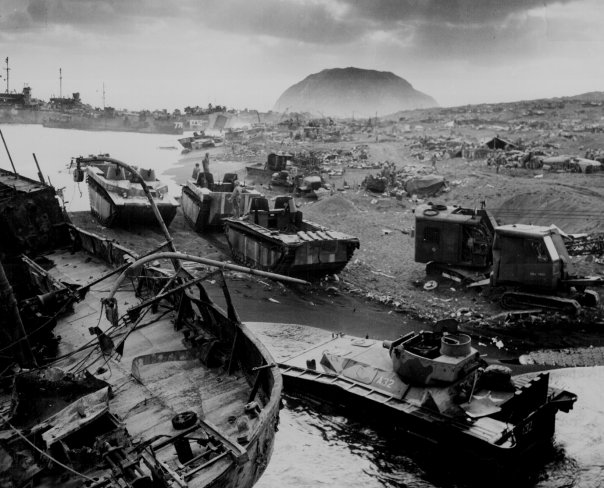
Iwo Jima -65 Years Ago Today -Part 1
February 16, 2010
February 16-17, 1945
The experienced V Amphibious Corps under Major General Harry Schmidt, USMC, had assembled three Marine divisions, the 3d, 4th, and 5th. Schmidt would have the distinction of commanding the largest force of U.S. Marines ever committed in a single battle, a combined force which eventually totalled more than 80,000 men. Well above half of these Marines were veterans of earlier fighting in the Pacific; realistic training had prepared the newcomers well. The troops being assembled were arguably the most proficient amphibious forces the world had seen.
Admirals Spruance and Turner prevailed upon Lieutenant General Holland M. Smith, then commanding Fleet Marine Forces, Pacific, to participate in what became known as Operation Detachment; as Commanding General, Expeditionary Troops. This was a gratuitous billet. Schmidt had the rank, experience, staff, and resources to execute corps-level responsibility without being second-guessed by another headquarters. Smith, the amphibious pioneer and veteran of landings in the Aleutians, Gilberts, Marshalls, and Marianas, admitted to being embarrassed by the assignment. "My sun had almost set by then," he stated, "I think they asked me along only in case something happened to Harry Schmidt."
The physical separation of the three divisions, from Guam to Hawaii, had no adverse effect on preparatory training. Where it counted most—the proficiency of small units in amphibious landings and combined-arms assaults on fortified positions—each division was well prepared for the forthcoming invasion.
The 3d Marine Division had just completed its participation in the successful recapture of Guam; field training often extended to active combat patrols to root out die-hard Japanese survivors.
In Maui, the 4th Marine Division prepared for its fourth major assault landing in 13 months with quiet confidence. Recalled Major Frederick J. Karch, operations officer for the 14th Marines, "we had a continuity there of veterans that was just unbeatable."
In neighboring Hawaii, the 5th Marine Division calmly prepared for its first combat experience. The unit's newness would prove misleading. Well above half of the officers and men were veterans, including a number of former Marine parachutists and a few Raiders who had first fought in the Solomons. Lieutenant Colonel Donn J. Robertson took command of the 3d Battalion, 27th Marines, barely two weeks before embarkation and immediately ordered it into the field for a sustained live-firing exercise. Its competence and confidence impressed him. "These were professionals," he concluded.
Among the veterans preparing for battle were two Medal of Honor recipients from the Guadalcanal campaign, Gunnery Sergeant John "Manila John" Basilone and Lieutenant Colonel Robert E. Galer. Headquarters Marine Corps preferred to keep such distinguished veterans in the states for morale purposes, but both men wrangled their way back overseas—Basilone leading a machine gun platoon, Galer delivering a new radar unit for employment with the Landing Force Air Support Control Unit.
The Guadalcanal veterans would only shake their heads at the abundance of amphibious shipping available for Operation Detachment. Admiral Turner would command 495 ships, of which fully 140 were amphibiously configured, the whole array 10 times the size of Guadalcanal's task force. Still there were problems. So many of the ships and crews were new that each rehearsal featured embarrassing collisions and other accidents. The new TD-18 bulldozers were found to be an inch too wide for the medium landing craft (LCMs). The newly modified M4A3 Sherman tanks proved so heavy that the LCMs rode with dangerously low freeboards. Likewise, 105mm howitzers overloaded the amphibious trucks (DUKWs) to the point of near unseaworthiness.
65 years ago today.....
The V Amphibious Corps left the Marianas Islands and steamed north / northeast.
Their destination was now revealed to the Marines aboard the ships.
In Japanese, it's name means "Sulphur Island".
It was an ugly, barren, foul-smelling chunk of volcanic sand and rock, barely 10 square miles in size. As described by one Imperial Army staff officer, the place was "an island of sulphur, no water, no sparrow, no swallow." Less poetic American officers saw the resemblance to a pork chop, with the 556-foot dormant volcano Mount Suribachi dominating the narrow southern end, overlooking the only potential landing beaches. To the north, the land rose unevenly onto the Motoyama Plateau, falling off sharply along the coasts into steep cliffs and canyons. The terrain in the north represented a defender's dream: broken, convoluted, cave-dotted, a "jungle of stone." Wreathed by volcanic steam, the twisted landscape appeared ungodly, almost moon-like. More than one surviving Marine compared the island to something out of Dante's Inferno.
This was Iwo Jima.
[Over the next few days, I will relate to you the story of the Battle of Iwo Jima, some truths, some myths, the iconic photo, the six flag-raisers and how some boys from Mansfield, Mass.played a part.]
